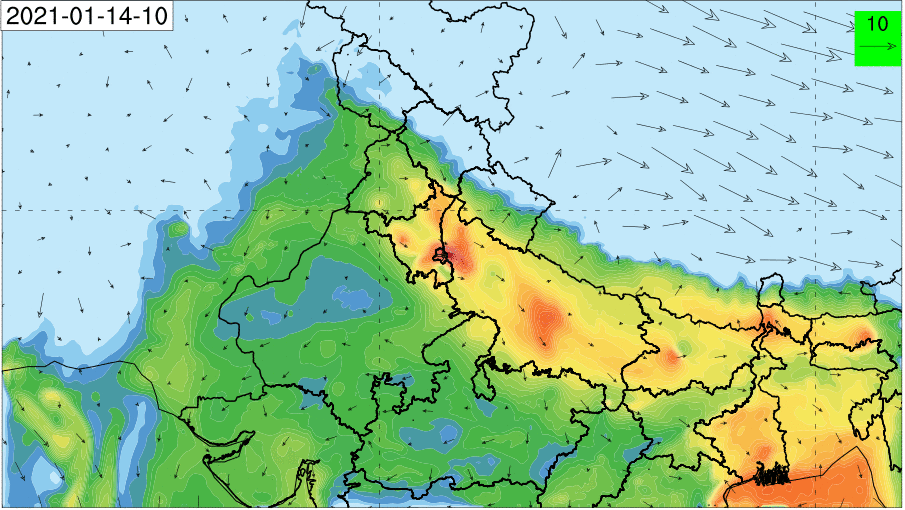RAC Poster Session
Training in AI/ML Videos
Seminars / Lectures
IITM Publication Highlights
A study of field-scale soil moisture variability using the COsmic-ray Soil Moisture Observing System (COSMOS) at IITM Pune site
 This study presents an analysis of daily field-scale soil-moisture (SM) variations, measured using the COsmic-ray Soil Moisture Observing System (COSMOS), over a tropical monsoon site (IITM, Pune) in India, for the period 2017–2020. Being located in the core zone of the Indian summer monsoon, the daily field-scale SM observations at COSMOS-IITM provide an unique opportunity to understand the SM response to monsoon precipitation variations on sub-seasonal, seasonal and interannual time-scales. This study highlights a longer persistence of SM memory time-scale (about 60 days) during 2019 as compared to 2017, 2018 and 2020. The validation of coarser resolution data sets revealed that GLDAS and ERA5 reasonably capture a range of observed field-scale SM variabilities over COSMOS-IITM site.
This study presents an analysis of daily field-scale soil-moisture (SM) variations, measured using the COsmic-ray Soil Moisture Observing System (COSMOS), over a tropical monsoon site (IITM, Pune) in India, for the period 2017–2020. Being located in the core zone of the Indian summer monsoon, the daily field-scale SM observations at COSMOS-IITM provide an unique opportunity to understand the SM response to monsoon precipitation variations on sub-seasonal, seasonal and interannual time-scales. This study highlights a longer persistence of SM memory time-scale (about 60 days) during 2019 as compared to 2017, 2018 and 2020. The validation of coarser resolution data sets revealed that GLDAS and ERA5 reasonably capture a range of observed field-scale SM variabilities over COSMOS-IITM site.
(Mujumdar M., Goswami M.M., Morrison R., Evans J.G., Ganeshi N., Sabade S.S., Krishnan R., Patil S.N., Journal of Hydrology, 597: 126102, June 2021, DOI: 10.1016/j.jhydrol.2021.126102, 1-13)
Revisiting Andhi in northern India: A case study of severe dust-storm over the urban megacity of New Delhi
 Pre-monsoon dust storms also known as “Andhi” are one of the common phenomena occurring over the northern part of Indian sub-continent. Using the synergetic information from multiple platforms, the life cycle of an infamous dust storm event has been investigated, which impacted the urban megacity of New Delhi on May 30, 2014. The analysis from the radar revealed that the storm resulted from the merger of the outflow boundaries of two propagating thunderstorms in the mesoscale vicinity of New Delhi region. The leading edge of the outflow of downdraft cold air generated from the storm, ploughs the loose hot soil from the surface, thereby resulting to the severe dust storm over the region. Although the study is centered at one event, the inferences distilled from this study are beneficial for the improvement of the predictive capability of severe weather events particularly for the tropical countries.
Pre-monsoon dust storms also known as “Andhi” are one of the common phenomena occurring over the northern part of Indian sub-continent. Using the synergetic information from multiple platforms, the life cycle of an infamous dust storm event has been investigated, which impacted the urban megacity of New Delhi on May 30, 2014. The analysis from the radar revealed that the storm resulted from the merger of the outflow boundaries of two propagating thunderstorms in the mesoscale vicinity of New Delhi region. The leading edge of the outflow of downdraft cold air generated from the storm, ploughs the loose hot soil from the surface, thereby resulting to the severe dust storm over the region. Although the study is centered at one event, the inferences distilled from this study are beneficial for the improvement of the predictive capability of severe weather events particularly for the tropical countries.
(Chakravarty Kaustav, Vincent V., Vellore R., Srivastava A.K., Rastogi R., Soni V.K., Urban Climate, 37: 100825, May 2021, DOI:10.1016/j.uclim.2021.100825, 1-11)
Influence of multi-mission chlorophyll-a data on the simulation of upper ocean thermal structure in the eastern Pacific Ocean
 The importance of providing multi satellite-based chlorophyll-a in an ocean model for accurate representation of penetrative shortwave radiation is demonstrated in this study using Modular Ocean Model. It questions the traditional usage of chlorophyll-a climatology in models. The model sensitivity experiments Chl_IA (with interannually varying multi satellite-based chlorophyll-a) and Chl_Clim (with chlorophyll-a climatology) during 1998–2016 reveals the importance of using the interannual chlorophyll. The present study advocates the use of multi satellite-based interannually varying chlorophyll-a observations to study the variability of Pacific Ocean using OGCM.
The importance of providing multi satellite-based chlorophyll-a in an ocean model for accurate representation of penetrative shortwave radiation is demonstrated in this study using Modular Ocean Model. It questions the traditional usage of chlorophyll-a climatology in models. The model sensitivity experiments Chl_IA (with interannually varying multi satellite-based chlorophyll-a) and Chl_Clim (with chlorophyll-a climatology) during 1998–2016 reveals the importance of using the interannual chlorophyll. The present study advocates the use of multi satellite-based interannually varying chlorophyll-a observations to study the variability of Pacific Ocean using OGCM.
(Karmakar Ananya, Parekh A., Chowdary J.S., Gnanaseelan C., International Journal of Remote Sensing, 42, May 2021, DOI:10.1080/2150704X.2021.1875146, 3445-3455)
Improved air quality during COVID-19 at an urban megacity over the Indo-Gangetic Basin: From stringent to relaxed lockdown phases
 The study observed a significant reduction in absorbing aerosol loading across the IGB during the enforced lockdown amid COVID-19 pandemic. Except O3, a drastic reduction was observed in the measured near-surface pollutant levels, i.e., PM10 (~58%), PM2.5 (~47%), NO (~76%), NO2 (~68%) and CO (~58%) during the lockdown period of 2020 as compared to 2019. While, O3 was low in the initial phase and a gradual increase was observed with the progression of lockdown phases, the mean O3 during the entire lockdown period was nearly similar in both the years. Though, all the measured pollutants showed significant reduction during the entire lockdown, a phase-wise enhancement, associated with the conditional relaxations was observed in their concentrations. The results of the study may help, not only to assess the impact of outbreak on air quality, but also in designing the mitigation policies in urban megacities in more efficient ways to combat the air pollution problems.
The study observed a significant reduction in absorbing aerosol loading across the IGB during the enforced lockdown amid COVID-19 pandemic. Except O3, a drastic reduction was observed in the measured near-surface pollutant levels, i.e., PM10 (~58%), PM2.5 (~47%), NO (~76%), NO2 (~68%) and CO (~58%) during the lockdown period of 2020 as compared to 2019. While, O3 was low in the initial phase and a gradual increase was observed with the progression of lockdown phases, the mean O3 during the entire lockdown period was nearly similar in both the years. Though, all the measured pollutants showed significant reduction during the entire lockdown, a phase-wise enhancement, associated with the conditional relaxations was observed in their concentrations. The results of the study may help, not only to assess the impact of outbreak on air quality, but also in designing the mitigation policies in urban megacities in more efficient ways to combat the air pollution problems.
(Srivastava Atul K., Bhoyar P.D., Kanawade V.P., Devara P.C.S., Thomas A., Soni V.K., Urban Climate, 36: 100791, March 2021, DOI: 10.1016/j.uclim.2021.100791, 1-13)
New Publications
Impact of middle atmospheric humidity on boundary layer turbulence and clouds
Malap N., Prabhakaran Thara, Karipot A., Journal of Atmospheric and Solar Terrestrial Physics, 215: 105553, April 2021, DOI: 10.1016/j.jastp.2021.105553, 1-14
Black carbon over a central Himalayan Glacier (Satopanth): Pathwaysand direct radiative impacts
Panicker A.S., Sandeep K., Gautam A.S., Trimbake H.K., Nainwal H.C., Beig G., Bisht D.S., Das S., Science of the Total Environment, 766: 144242, April 2021, DOI:10.1016/j.scitotenv.2020.144242, 1-8
Evaluating different lightning parameterization schemes to simulate lightning flash counts over Maharashtra, India
Mohan G.M., Vani K.G., Hazra A., Mallick C., Chaudhari H.S., Pokhrel S., Pawar S.D., Konwar M., Saha Subodh K., Das S.K., Deshpande S., Ghude S., Barth M.C., Rao Suryachandra A., Nanjundiah R.S., Rajeevan M., Atmospheric Research, 255: 105532, June 2021, DOI:10.1016/j.atmosres.2021.105532, 1-22
Atmospheric ice nucleating particle measurements and parameterization representative for Indian region
Anil Kumar V., Hazra A., Pandithurai G., Kulkarni G., Mohan G.M., Mukherjee Subrata, Leena P.P., Patil R.D., Prasad D.S.V.V.D., Atmospheric Research, 253: 105487, May 2021, DOI:10.1016/j.atmosres.2021.105487, 1-9
PDF Publisher LinkIITM Events

Virtual International Conference on the “Future directions of Subseasonal to Seasonal Prediction over South Asia”
IITM, Pune and the WWRP/WCRP Subseasonal-to-Seasonal (S2S) Prediction Project organized a Virtual International Conference on the "Future directions of Subseasonal to Seasonal Prediction over South Asia".

World Meteorological Day-2021
IITM celebrated the World Meteorological Day-2021. This year, Dr. T. Srinivasa Kumar, Director, INCOIS, Hyderabad delivered the World Meteorological Day Special Lecture (online) on “Societal Benefits of Ocean Information Services” in lines with the theme of WMO Day ‘the ocean, our climate and weather’ on 23 March 2021.








